Concurrent Programs
Details
All Order Management concurrent programs are classified as single-org, multi-org or global.
Single Org Concurrent Programs
You can run the following Concurrent Program for one Operating Unit (from the ones you have access to) at a time, without switching responsibility:
-
Re-schedule Ship Sets
-
Diagnostics: OM Order Information
The mandatory Operating Unit parameter in the submit request window displays a default value.
Multi-Org Concurrent Programs
These programs have the Operating Unit as a parameter. You can run these Concurrent Programs either for an Operating Unit at a time (by specifying an Operating Unit value) or for all Operating Units that you have access to (by leaving the Operating Unit parameter blank):
-
Audit History Consolidator
-
Credit Check Processor
-
Credit Exposure Import
-
Export Compliance Screening
-
High Volume Order Import
-
Included Items Freeze at Pick Release
-
Inventory Interface – non ship
-
Order Import
-
Order Purge Selection
-
Process Pending Payments
-
Progress from Firm Process
-
Purchase Release
-
Purge Imported Credit Exposure
-
Purge Open Interface Data
-
Purge Retrobilling Requests
-
Quote Purge Selection
-
Release Expired Hold
-
Reserve Orders
-
Schedule Order
-
Show Sales Order
For these programs the Operating Unit parameter in the submit request window is disabled and you can optionally specify an Operating Unit in the parameter window.
Operating Unit Sensitive Parameters
The parameter LOVs for Operating Unit sensitive data (see list below) show the Operating Unit name. If there is no default or user specified Operating Unit Value then the LOVs show data across all Operating Units accessible to you. If you have specified an operating unit, then the LOVs restrict data to that particular Operating Unit.
These are the various concurrent request parameters that are Operating Unit sensitive:
-
Bill To Location
-
Customer PO Number*
-
Quote Number Low/High*
-
Order Number Low/High*
-
Order Reference*
-
Order Type
-
Line Type
-
Request Name (Retro-Billing Request Name)
-
Ship To Location
-
Ship Set
* - While the LOVs for these fields will show Operating Unit, if you do not specify an Operating Unit parameter, specifying these alone will not necessarily restrict output by Operating Unit. If you want to restrict data by Operating Unit, specify an operating unit as a parameter.
Important: It is recommended that if you want to pick Operating Unit sensitive parameter(s), you should first select the Operating Unit, as this will automatically restrict all the OU sensitive parameter LOVs to the selected Operating Unit.
In the case where you have not specified an Operating Unit and you then pick an Operating Unit sensitive parameter value, the Operating Unit parameter field will remain blank (it is not defaulted based on the other parameter value selection) and other OU sensitive parameter LOVs will continue showing data across all accessible OUs. Provided that all the different Operating Unit sensitive parameters are for the same OU then the program will process data in that specific Operating Unit alone. If they are not, then the concurrent program will process nothing.
Concurrent Programs that let users specify an Inventory Item value as a parameter: The LOV for the Item parameter relies on the Item Validation Org System Parameter. If you have specified an Operating Unit parameter, the item LOV will show data based on the Item Validation Org for that Operating Unit. If you have not specified an Operating Unit, then the LOV will show data based on the Item Validation Org for your default Operating Unit. If you do not have a default Operating Unit then the LOV will return no values.
Global Concurrent Programs
The following concurrent programs are global (process data across Operating Units).
-
Calculate Party Totals
-
Generate Constraints Validation Packages
-
Defaulting Generator
-
Diagnostics: Apps Check
-
Diagnostics: OM Debug File Retrieval
-
Initialize Credit Summaries
-
Order Import Statistics
-
Purge Advanced Item Search Session Data
-
Retry Activities In Error
-
Message Purge
For these programs the Operating Unit parameter in the submit request window is disabled and they do NOT have an Operating Unit parameter in the parameters window.
Schedule Orders Concurrent Program
You can schedule lines that have failed workflow scheduling by running the concurrent program. The concurrent program:
-
Obtains additional scheduling attributes including delivery lead times and shipping methods
-
Obtains a ship from location for order lines
-
Obtains the schedule date and warehouse for order lines
-
Reserves order lines if the lines are within the reservation time period
The Schedule Orders concurrent program scheduled only those lines that had failed workflow scheduling. In the current release, apart from being able to schedule lines that have failed workflow scheduling, manually entered lines in the Entered status can be scheduled periodically using the Schedule Orders concurrent program, or unscheduled lines imported in Entered status can be scheduled. Additionally, orders that have been imported and are in Entered status can also be scheduled using the enhanced Schedule Orders concurrent program.
If the program fails such as the schedule date for an item could not be found, Order Management returns an error for the line. The lines which fail scheduling can be scheduled in the next run of the program. All lines that are successfully scheduled are placed on demand and the next planning run and pick this line up as demand.
Schedule Orders concurrent program processes order lines you specify by using the parameters listed above, if the line is not already scheduled. The Schedule Orders Concurrent program performs the following:
-
Checks for any holds on the order. If a hold exists and the system parameter OM: Schedule Line on Hold is set to No, the program ignores the order. If the system parameter is set to Yes, the order continues to the next step.
-
Query the lines of the order and lock the line. If locking fails, it will print a message and skip the order.
For each line of the order, the Schedule Orders Concurrent Program:
-
Checks the workflow status to verify that the line is eligible for scheduling
-
Checks if the line needs scheduling. Process only if it needs scheduling
-
Check if the line is on hold. If there is a hold and if the system parameter OM: Schedule Line on Hold is set to No, skip the line
-
Adds the line to the list of lines ready to be scheduled
-
Schedule the line
Note: If scheduling was successful, it will complete the scheduling workflow activity with the result of Complete so that the line can progress to the next activity. If scheduling was unsuccessful, the workflow activity displays the result of Incomplete.
User Procedures
-
Navigate to the Run Requests window, and select Schedule Orders in the Name field.
Schedule Orders Input Parameters Window
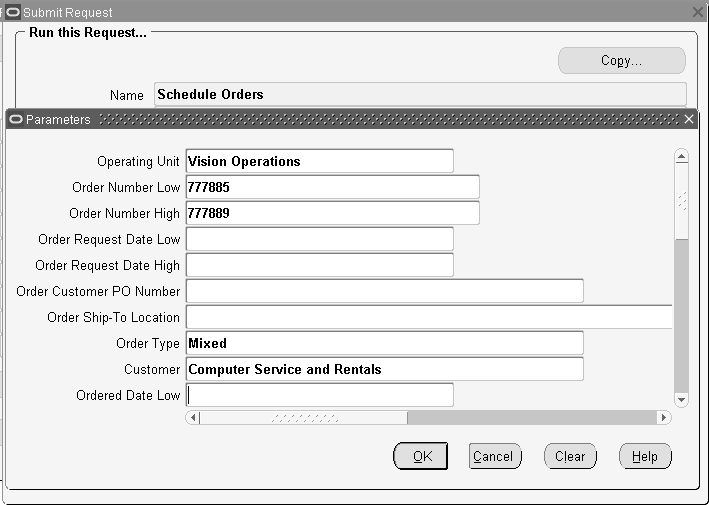
-
Determine the order(s) you wish to schedule. You can use the following parameters for scheduling orders:
-
Operating Unit
-
Order Number Low
-
Order Number High
-
Order Request Date Low
-
Order Request Date High
-
Order Customer PO Number
-
Order Ship-To Location
-
Order Type
-
Customer
-
Ordered Date Low
-
Ordered Date High
-
Warehouse
-
Item
-
Demand Class
-
Planning Priority
-
Shipment Priority
-
Line Type
-
Request Date Low
-
Request Date High
-
Ship-to Location
-
Schedule Ship Date Low
-
Schedule Ship Date High
-
Schedule Arrival Date Low
-
Schedule Arrival Date High
-
Booked
-
Scheduling Mode
-
Apply - Warehouse
-
Apply - Schedule Date
-
First Order By
-
Second Order By
Note: A business flow could require a customer service representative (CSR) to enter orders without scheduling, to save time. Later, Schedule Orders will schedule the order lines.
-
-
Select OK, then Submit
Sorting
You can sort the sequence of line scheduling; setting the scheduling priority, using the sorting parameters First Order By and Second Order By and the following:
-
Request date
-
Demand class
-
Shipment priority
-
Planning Priority
-
Schedule Ship date
-
Schedule Arrival date
-
Line Creation Date
For items with no supply constraints, all lines will schedule, lowering the dependence on the Sort By parameters. For ATP items, the Sort By parameter is useful, especially if an API is written to implement specific business rules.
Note: Note : Sorting is based on line level columns. Sorting for the Shipment Priority and Demand Class is based on the internal lookup codes and not the values
Schedule Date and Warehouse
You can query lines, and assign either a new Schedule Ship Date (this can be Schedule Ship Date or Schedule Arrival date; depending on the Order Date Type value) or Warehouse when re-scheduling a line, and have the flexibly to change to a location meeting the schedule requirements.
This is currently possible with Scheduling Across Orders (SAO), but for high volume, you can change the Schedule Date in batch mode.
Unscheduling
You can run this program with Scheduling mode set to ' Unschedule ' to unschedule all scheduled lines or using Schedule Orders concurrent program, you can choose to unschedule selected lines, formerly accomplished through the Sales Orders window.
Rescheduling
Schedule Orders provides two new scheduling modes to reschedule orders; Re-Schedule and Re-scheduling with Request Date. You can query scheduled lines and perform a reschedule. You can move schedules in and out based on the item’s availability, and if orders or delivery schedules from suppliers are changed or cancelled, then the allocated product can be rescheduled to meet other demands earlier or later.
Scheduling Mode
Schedule Orders concurrent program works for all unscheduled lines and the sales order lines may or may not be waiting at Schedule – Eligible activity.
Lines at Eligible Activity
Only selected lines waiting at the Schedule-Eligible workflow activity are selected. The default is no value entered. Note that the lines may or may not be scheduled and still could be waiting at the activity. If no value is entered for the Scheduling Mode parameter, this will be the default mode.
Schedule (all Unscheduled lines)
All unscheduled lines are chosen and scheduled. If a line is waiting at the Schedule-Eligible activity, then the activity is progressed after scheduling completion. You can also specify the Scheduling attributes (warehouse, date).
Unschedule: Unschedules all the selected lines. Only scheduled lines are queried.
Re-Schedule with Request Date:Lines are re-scheduled by using the Request Date instead of Schedule Ship Date or Schedule Arrival Date. Only scheduled lines will be queried.
Re-Schedule: Lines are re-scheduled by using the specified scheduling attributes (warehouse, date). If no scheduling attributes are entered, then the existing line level attributes (warehouse, date) will be used for re-scheduling.
If the re-scheduling action is not successful, then the line is left unchanged, so the line remains scheduled. You can avoid high-risk failures by performing an unschedule and then schedule appropriately. Scheduling attributes are supported only for Schedule or Re-schedule modes.
Sets (Ship, Arrival) and Configurations
If the query includes one line in a Set (ship, arrival) SMC PTO Model, or ATO Model, then all the lines in the Set or SMC PTO Model or ATO Model will be scheduled. The exception is when the Schedule Mode is Schedule without any scheduling attributes. In this case the top model with included item/Optional item/Optional class are scheduled. If the query includes a line with PTO Model, Kit, or a PTO Class, then the included items will also be scheduled with the parent. The Unschedule action is not supported for lines belonging to Sets (Ship, Arrival).
Other Scheduling User Procedures
Scheduling Orders that were never scheduled
-
Set the profile option OM: Auto Schedule to No. The lines will not schedule at the time of entry.
-
Enter a sales order header and lines, and then save the order making sure it was not scheduled.
-
Schedule Order concurrent program – Enter the search parameters. Enter the value Schedule in the parameter Scheduling Mode. Optionally enter a scheduling attribute and submit the request:
-
Schedule date
-
Warehouse
-
-
Verify that the request has completed, then view the order in the Sales Orders window, checking any scheduling attributes you have made. To schedule lines that have failed workflow scheduling, and only those lines, choose the value Lines at Eligible Activity, in the Scheduling Mode parameter.
Scheduling Booked orders
-
Set the profile option OM: Auto Schedule to No. The lines will not schedule at the time of entry.
-
Create two sales orders, headers and lines, and book only one.
-
Schedule Order concurrent program – Enter the search parameters. Enter the value Yes in the parameter New Query, and submit the request.
-
Verify that the request has completed, and then view the orders in the Sales Orders window, checking to see if only the booked order was scheduled.
Re-Schedule Lines that have been scheduled
-
Enter a sales order header and lines, schedule the lines, and then save the order.
-
Schedule Order concurrent program – Enter the search parameters. Enter the value Re-Schedule in the parameter Scheduling Mode. You need to enter either or both scheduling attribute(s) and submit the request:
-
Schedule date
-
Warehouse
-
-
Verify that the request has completed, and then view the orders in the Sales Orders window, checking to see if the values entered are there.
Some factors to consider: If the re-scheduling action is not successful, the line is unchanged, which implies that the line will still be scheduled. You have to determine the number of failed lines from the concurrent request log or the Process Messages window. It is advisable to follow a two-step re-scheduling process, which is to unschedule first and then schedule appropriately. Please note that Scheduling attributes will be supported only for Schedule or Re-schedule modes.
Un-Schedule the Lines that have been scheduled
-
Enter a sales order header and lines, schedule the lines, and then save the order.
-
Schedule Order concurrent program – Enter the search parameters. Enter the value Unschedule in the parameter Scheduling Mode. Submit the request.
-
Verify that the request has completed, and then view the orders in the Sales Orders window, checking to see if the lines are unscheduled with the Scheduled Ship Date blank.
Results and Exceptions
Scheduling failures are written to the concurrent request log file. In addition, error messages will also be stored in the process messages table with the Concurrent Request ID, Order and Line Details. Process Messages Form can be used to query the messages for the Request Run or a particular order.
Summary processing statistics like the number of processed lines and number of failed lines will be printed at the end of the concurrent request log file.
If the number of Sales order lines scheduled in the batch are small, then Schedule Across Orders module can be used to query back the results by using the appropriate fields in the find window.
Workflow - Manual Scheduling Sub-Process
A scheduling sub-process named Schedule-Line, Manual handles situations where you want to control scheduling manually after the order is booked. If the new sub-process is used in the line workflow, then after booking the order, the lines will be blocked at the Schedule-Eligible activity. You can progress the Schedule-Eligible activity from Sales Orders window or use the Schedule Orders program to schedule the lines.
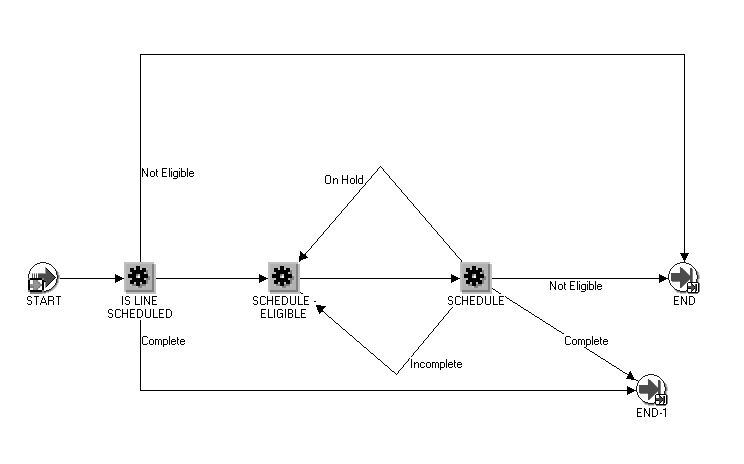
Release Expired Holds Concurrent Program
Order Management provides the ability to release all expired holds by effectivity date.
There are no enterable input parameters for this program: When the concurrent program is called, all expired holds with an ending Effectivity Date less than or equal to the system date will automatically be released.
To release Expired Holds:
-
Navigate to the Run Requests SRS window, and select Release Expired Holds in the Request Name field.
-
Select OK, then Submit.
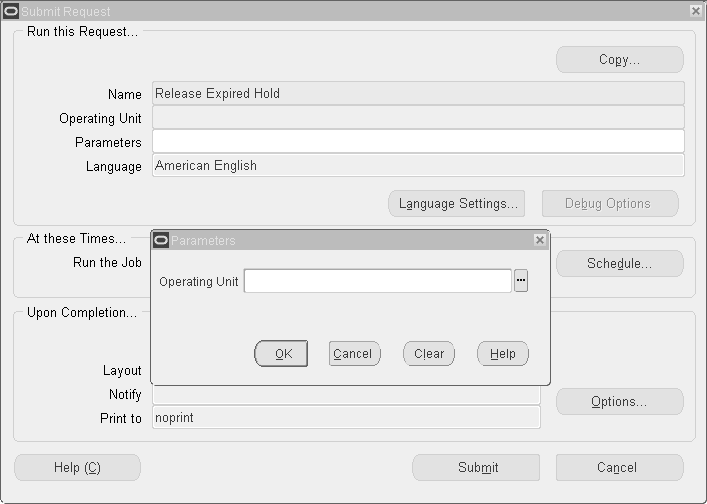
Defaulting Generator Concurrent Program
The Defaulting Generator concurrent program enables you to quickly update existing defaulting packages for defaulting rules and conditions. From the Order Management Standard Request Submission window, you can choose to submit the program for
-
an Application and Entity
-
an Application, Entity, and Attribute
-
Whenever defaulting rules/conditions are updated for an attribute, the Defaulting Generator concurrent program must be run to generate new defaulting packages for that attribute. The Defaulting Rules form will display a note reminding users to run this program when updates are saved.
-
Whenever validation rules for a defaulting condition are updated, the Defaulting Generator concurrent program must be submitted for the Entity updated in order for the updates to be processed. Defaulting packages needs to be re-generated for all attributes whenever a defaulting condition's validation rules are updated.
-
You may execute the Defaulting Generator concurrent program while users are still on the system, although the defaulting package may not generate successfully. This can be due to the package currently being called by other users who are processing orders on the system. Common errors within the output log file for this concurrent program may contain text that a time-out occurred while waiting to lock object.
Note: If you are running Defaulting Generators for an Entity and do not specify an Attribute, it is recommended that users log off the system to decrease the concurrent processing run time.
Note: If defaulting packages do not generate successfully, you must choose to run the concurrent program at a later time, or have users briefly log off the system while defaulting packages are being regenerated in order for your modifications to take effect.
To submit the Defaulting Generator concurrent program from within the Defaulting Rules window:
-
Within the Defaulting Rules main window, from the Tools menu, select Defaulting Generator.
You can only submit the concurrent program from the Defaulting Rules main window. If you choose to submit the concurrent program from the Defaulting Rules window, input parameters are based upon the current cursor location. The Defaulting Generator is run for whatever attribute is highlighted.
For example, if the field Application has a value of Oracle Order Management, the field Entity has a value of Order Header, and the cursor was positioned on the row displaying the attribute Agreement, the concurrent program will be executed with the above values as input parameters.
Note: From within the Defaulting Rules window, the Defaulting Generator concurrent program is always submitted with a value for the input parameter Attribute, which is based upon the cursor location when the concurrent program is invoked.
To submit the Defaulting Generator concurrent program from the Order Management SRS window:
Navigate to the Run Requests SRS window, and select Defaulting Generator in the Request Name field.
Run Requests SRS Window
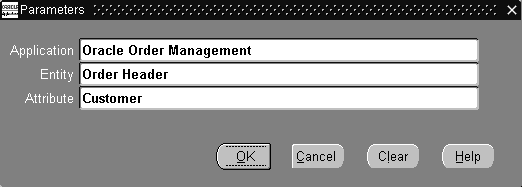
-
Select a value for the Application. This field is required.
-
Select a value for the Entity. This field is required.
Running this program with only a value for the input parameter 'Entity' will result in re-generating defaulting packages for every defaultable attribute for the entity value selected.
-
Select a value for the Attribute. This field is optional.
Running this program with a value for the input parameter 'Attribute' results in re-generating the defaulting logic for the attribute value selected only. All other attribute rules and conditions of the entity will not be re-generated.
-
Select OK, then Submit.
Inventory Interface No Ship Concurrent Program
The Inventory Interface concurrent program processes interfacing orders or lines to inventory if:
-
The order or line has failed during a previous execution of the Inventory Transaction worker
-
If the current status for the Inventory Interface- Eligible activity within the workflow subprocess for the Inventory Interface has a value of Wait
In order for the Inventory Interface concurrent program to properly function, you must customize order or line workflow processing flows to include the Inventory Interface - Eligible block activity before the Inventory Interface sub process.
The Inventory Interface concurrent program creates a standard Oracle log file containing processing results for the programs execution.
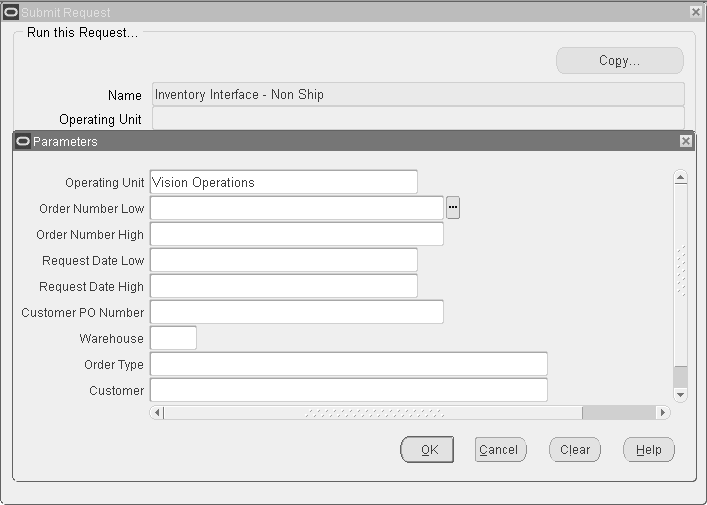
-
The Inventory Interface No Ship concurrent program will process lines that are awaiting completion of the Inventory Interface for Non Ship flows only.
-
Order lines may be in this state (awaiting completion) as a result of certain validation failures that occur when Order Management originally attempted to Inventory Interface said lines.
-
Under normal circumstances, order lines will complete the Inventory Interface No Ship workflow sub process without any errors and therefore not be in an Eligible state.
-
This concurrent program does not process any order lines that have failed Inventory Interface on regular order line Ship flows.
To process Inventory Interface transactions via concurrent program:
-
Navigate to the Run Requests SRS window, and select Inventory Interface in the Request Name field.
Run Requests SRS Window
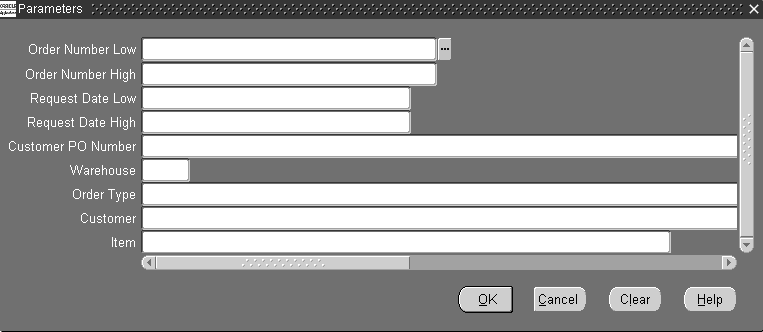
-
In the parameters window, select a value for the following parameters, based upon your processing needs:
-
Order Number Low
-
Order Number High
-
Request Date Low
-
Request Date High
-
Customer PO Number
-
Order Type
-
Customer
-
Item
-
Warehouse
-
-
-
Select OK, then Submit.
Credit Check Processor Concurrent Program
The Credit Check Processor program can be run on demand to re evaluate Booked orders that have not been shipped yet.
Use the Credit Check Processor when you suspect that your customers credit exposure has changed and you want to re evaluate their sales order status (releasing or applying credit check holds accordingly).
Also use Credit check Processor whenever you change your customer or default credit set up and you want this changes to immediately take affect in your booked sales orders.
The program only can be used if you run credit checking at Book, only for booked orders (all orders are booked).
To re evaluate booked orders not yet shipped via concurrent program:
-
Navigate to the Run Requests window, and select Credit Check Processor in the Name field.

-
Determine which customer credit profile classes to include when updating your credit balances. Select either a value for Customer Profile Class From, Customer Profile Class To, or by selecting a value for both fields.
-
Determine which customers to include when updating your credit balances. Select either a value for Customer Names From, Customer Names To, select a value for both fields, or choose to include or exclude customer names within the range selected for Customer Names From/To by selecting additional limiting values for the input parameters Customer Numbers From/To.
-
Determine which customers to include when updating your credit balances. Select either a value for Customer Numbers From, Customer Numbers To, select a value for both fields, or choose to include or exclude customer numbers within the range selected for Customer Numbers From/To by selecting additional limiting values for the input parameters Customer Names From/To.
-
Determine the order dates to include when updating your credit balances. Select a value for Order Date From, an optional value for Order Date to, or by selecting a value for both fields. Order Date From is required.
-
Determine the processing order when updating credit balances. Select a value for the Order sequence field. This field is required. Possible values are:
-
Earliest Order Date First
-
Earliest Ship Date First
-
Greatest Order Value first
-
-
Select OK, then Submit.
Initialize Credit Summaries Table Concurrent Program
Order Management enables you to periodically rebuild a credit exposure image (orders, invoices and payments) for all customers or customer sites for all possible credit rule definitions. When you submit the, The Initialize Credit Summaries Table concurrent program, changes to customer or customer site credit exposure are calculated and updated, based upon your exposure setup for each credit check rule defined. Exposure information is stored in a summary table so that the credit check process can refer to summary credit data as opposed to real time transactional data, reducing the effort needed to evaluate credit standing.
Additionally, if you wish to import exposure details from an external system, you can use the Credit Exposure Import concurrent program. See: Credit Exposure Import Concurrent Program.
-
Exposure summary information is used only during the credit checking process if you have selected the Use Pre-Calculated Exposure check box within the Exposure tab on the Credit Check Rules window.
-
The Credit Check Rules are always checked from the Order Transaction Type, whether line level credit checking is performed or order level is checked by looking at the Credit Check Rule itself.
-
Do not submit the program too frequently, as system resources may be affected. It is recommended that you build credit exposure at least once a day during off business hours.
-
Ensure that you allow enough time for the program to complete before rescheduling it to run again.
-
When you submit this concurrent program, if you have externally imported exposure records within the summary table, they are not overwritten.
To initialize or update credit exposure via concurrent program:
-
Navigate to the Run Requests SRS window, and select Initialize Credit Summary Table in the Request Name field.
Run Requests SRS Window - Initialize Credit Summary Table
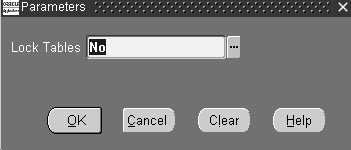
-
Determine whether or not you wish to lock database tables when submitting this program. Select from:
-
Yes: Lock database tables during execution of this program. When you lock a database table, you are not allowed to modify any aspects of any record within the table that is locked.
-
No: Do not lock tables during the submission and execution of this concurrent program.
This parameter is required.
-
-
Select OK, then Submit.
Credit Exposure Import Concurrent Program
The Credit Exposure Import concurrent program enables you to import external credit exposure details (such as transaction amounts for sales orders created outside of Oracle Applications) into Oracle Order Management, provided you have correctly populated the corresponding Order Management Exposure Interface table.
External exposure details can then be:
-
Utilized exclusively for Credit Checking
-
Used in conjunction with existing pre-calculated exposure amounts when performing credit checking
-
Used in conjunction with real time transactional data when performing credit checking
Order Management will determine whether to include external exposure amounts imported within the overall exposure amount when performing credit checking based upon the credit checking rules you define.
Program Details
External exposure details imported within Order Management are stored in the same exposure summary table used by the Initialize Credit Summaries Table concurrent program. Successfully imported external exposure records within the summary exposure table can be determined by the value for the field BALANCE_TYPE; all externally imported exposure detail records will have the value 18 for the field BALANCE_TYPE.
Note: when you submit the Initialize Credit Exposure concurrent program, externally imported exposure records are never overwritten.
When importing credit exposure details from an external system, Order Management will import all records selected, provided each record successfully passes validation. If a single record fails validation, Order Management will not import any records within the exposure interface tables which were selected for processing. If you encounter exceptions during run time, review the exception details within the concurrent program output and log files, correct the issues, and then resubmit the program.
The Credit Exposure Import concurrent program can be submitted in two different modes, Update and Insert. Interface records are processed based upon the mode, which is determined by the value of the column OPERATION_CODE within the exposure interface table.
-
Insert: All credit exposure amounts previously imported will be overwritten with the given exposure amount within the Order Management Exposure Interface tables.
-
Update: The credit exposure amount within the Order Management Exposure Summary table will either be added (positive amount) or subtracted (negative amount) to any previously imported amount. If a corresponding exposure amount does not previously exist, a new exposure amount record will be created.
This program will never delete records from the credit exposure summary table.
Note: The current value of the profile option MO: Operating Unit is used as a input parameter to this concurrent program. This parameter is hidden by default, and is used to prevent the Credit Exposure Import program from importing exposure records into incorrect operating units.
Note: If you need to input exposure details for multiple operating units, Order Management recommends you set this profile option at the Responsibility level, and then switch to the corresponding Responsibility when importing exposure details.
To import credit exposure details from an external system:
-
Navigate to the Run Requests SRS window, and select Credit Exposure Import in the Request Name field.
Run Requests SRS Window - Credit Exposure Import

-
Select the Exposure Source. Exposure Sources are based upon user defined values for the Order Management Quick Code ONT: Credit Exposure Import Source. If you select a value for this parameter, only records which have the same value (case sensitive) within column EXPOSURE_SOURCE_CODE within the exposure import interfaces tables will be processed. This field is not required.
-
Enter a numeric value, greater than zero, if you wish to specify a batch number to process a portion of the records with the exposure import interface tables.
You can use a batch number for auditing purposes, or to improve performance when large amounts of exposure records are to be imported (choose to process only a portion of the exposure records within one submission and the remaining records within additional submissions - running the concurrent program in parallel with the initial request).
-
If you select a value for this parameter, only records which have the same value within column BATCH_ID within the exposure import interfaces tables will be processed. This field is not required.
-
Validate Only:
Select Yes to validate records within the credit exposure interface tables only. No records are imported into summary exposure tables during submission.
-
Select No to validate and process records within the credit exposure interface tables.
This field is required.
-
Select OK, then Submit.
Note: When importing exposure details using the Credit Exposure Import, only interface records that belong to a Bill To Site for the current operating unit can be imported. Therefore, ensure your records are grouped accordingly.
Note: For example, if you have multiple Bill To sites within the exposure interface table, ensure that each Bill To Sites has been previously defined for the current operating unit you are currently working within.
Note: Additionally, if you specify either an Exposure Source or a Batch Id as an input parameter, ensure the corresponding records (marked with values for either Exposure Source or Batch ID) within the interface table utilize Bill To Sites defined for the same operating unit you are submitting the program for.
Output
The Credit Exposure Import concurrent program produces a standard Oracle log file, along with a Standard Order Management Report output.
Concurrent Program Log File
-
The concurrent program log file contains standard details such as program name and the value of input parameters, as well as the following summary details:
Number of rows to Process: X_num_rows_to_process
Number of rows to Validate: x_num_rows_validated
Number of rows that failed Validation: x_num_rows_failed
Number of Rows Imported: x_num_rows_imported
Concurrent Program Output (report)
-
The concurrent program output (report output), available only by selecting Output within the View Requests window (provided your have previously selected the row with the appropriate request id) displays the following details:
Report Parameters Region
-
Concurrent program input parameters with values entered for submission.
Report Information
-
Concurrent program details such as request id
Report Header Region
-
Concurrent program details such as operating unit and report date.
Report Output
-
Concurrent program details such as Number of credit exposure to process, and Number of credit exposure failed validation.
-
Concurrent program exception details (errors).
-
Purge Imported Credit Exposure Concurrent Program
The Purge Imported Credit Exposure concurrent program enables you to purge imported external credit exposure records by operating unit and exposure source. If you have imported external credit exposure records for multiple operating units, in order to purge all external credit exposure records you will need to submit the concurrent program for each operating unit you have imported external credit exposure records for.
To purge credit exposure details which were imported from an external system:
-
Navigate to the Run Requests SRS window, and select Purge Imported Credit Exposure in the Request Name field.
Run Requests SRS Window - Purge Imported Credit Exposure

-
Select the Exposure Source, Exposure Sources are based upon user defined values for the Order Management Quick Code ONT: Credit Exposure Import Source. Prior to selecting a value for this parameter, ensure that external credit exposure records have previously been imported successfully. Otherwise, the program will fail.
-
Select ok, then Submit.
Note: The current value of the profile option MO: Operating Unit is used as a input parameter to this concurrent program. This parameter is hidden by default, and is used to prevent the Credit Exposure Import program from importing exposure records into other operating units.
If you need to purge exposure details for multiple operating units, Order Management recommends you set this profile option by responsibility, and then switch to the corresponding responsibility when purging exposure details.
Process Pending Payments Concurrent Program
The Process Pending Payments concurrent program enables you to submit credit card orders for payment processing and to additionally process orders on hold (for select hold types only). Orders using both a Payment Term that enables prepayments and a Payment Type of Credit Card, and orders with the following hold type are processed by this concurrent program:
-
ePayment Failure Hold
-
ePayment Server Failure Hold
-
Pending Process Payment (PPP) Hold
When you submit this concurrent program, orders with the above hold types are first released (provided the validation of removing the hold is successful); the order and order lines are then able to continue within their respective workflows.
This concurrent program produces an output log file and output listing with any error messages generated during processing. The following additional details can be located in the both the log file and concurrent program outputs:
-
Total orders processed during runtime (No. of orders found)
-
Total number of authorizations successful during runtime (No. of orders successful)
-
Total number of credit card holds released during runtime (No. of orders released)
-
Total number of orders not processed due to processing failure (No. of orders failed)
Additionally, you can use the Process Messages window to view concurrent program runtime details such as warning or error messages generated.
To process pending payments via concurrent program:
-
Navigate to the Run Requests window, and select Process Pending Payments in the Name field.
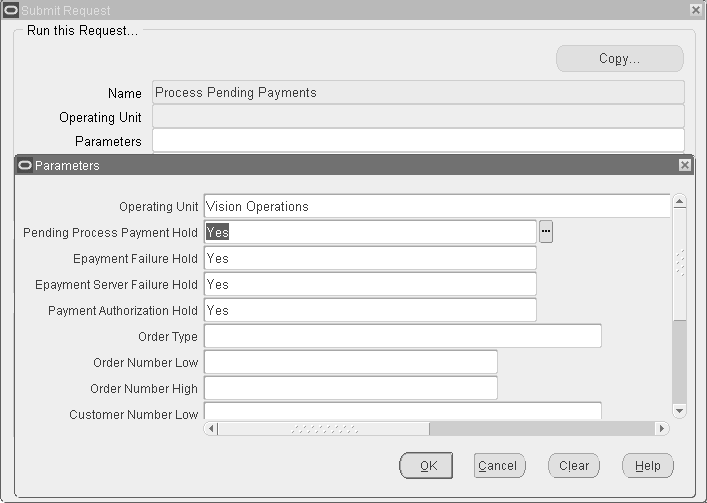
All input parameters to this concurrent program are optional.
-
Pending Payment Process Hold: Select Yes to process orders currently on Pending Payment Process Hold, or select No to not process orders on Pending Payment Process Hold. The default value for this parameter is Yes.
-
ePayment Failure Hold: Select Yes to process orders currently on ePayment Failure Hold, or select No to not process orders on ePayment Failure Hold. The default value for this parameter is Yes.
-
ePayment Server Failure Hold: Select Yes to process orders currently on ePayment Server Failure Hold, or select No to not process orders on ePayment Server Failure Hold. The default value for this parameter is Yes.
-
Payment Authorization Hold: Select Yes to process orders on Payment Authorization hold. Select No to bypass these orders. This hold is used if you set up payment authorization to be a deferred process. Then this request will attempt to process those authorizations in a batch mode.
-
Order Type: Select a specific order type to limit credit card payment processing of orders.
-
Order Number (Low/High): Enter a value for Order Number Low, Order Number High, or both to limit credit card payment processing to specific order numbers. If you wish to process a single order, enter the same value in both fields.
-
Customer Number (Low/High): Enter a value for Customer Number Low, Customer Number High, or both to limit credit card payment processing to orders for specific Customer numbers. If you wish to process credit card orders for a single customer, enter the same value in both fields.
-
Customer Class: Select a specific customer class to process credit card payments.
-
Credit Card Number: Enter a specific credit card number to process orders for credit card payment. Only orders with the specific card number entered will be processed.
-
Credit Card Type: Select a credit card type to process orders for credit card payment. Only orders with the specific credit card type will be processed.
-
Bill to Org: Select a specific Bill To to process credit card payments.
-
Booked Date Since: Enter a specific date to process all orders which have a creation date greater than or equal to the date entered for processing credit card payments.
-
Select OK, then Submit.
Message Purge Concurrent Program
The Message Purge concurrent program purges Order Management messages that are generated during order processing. To keep the Oracle Order Management Message tables at manageable sizes, you should submit the Message Purge concurrent program at periodic intervals. After the concurrent program has successfully completed, you can use the Process Messages window and to verify that the Order Management message tables have been purged as specified by the input selection criteria.
If you leave any of input parameters blank, the concurrent program will process all possible values for the parameter.
To purge Order Management messages via concurrent program:
-
Navigate to the Message Purge menu entry.
Message Purge Window
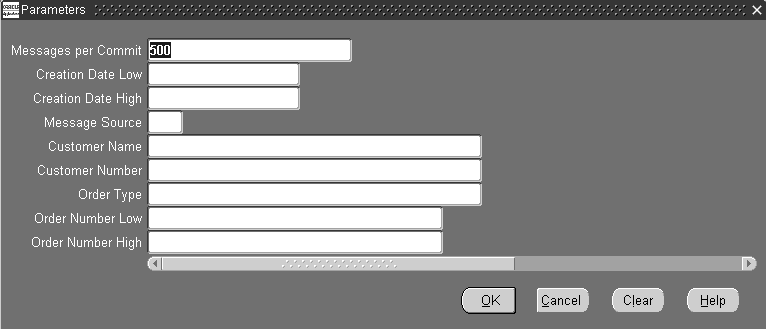
-
Determine the number of messages you wish to purge per database commit by entering a value for the Messages per Commit input parameter.
If you enter a value of 100, 100 messages will be purged (based upon all input parameters) prior to the database actually performing the commit. Once a commit has successfully completed, you are unable to rollback changes that occurred prior to the commit. In the event of a system failure, a rollback will be performed, rolling back any changes that took place immediately after the last successful commit. The default for this field is 500, and the field is optional.
-
Determine if you wish to purge messages created on a specific date or range of dates by selecting a value for the Creation Date Low, the Creation Date High, or both input parameters. All messages created for the date range specified are purged, provided other input parameters also enable purging. These fields are optional.
-
Determine a Message Source to purge Order Management messages. All messages created with the source specified by the input parameter Message Source will be purged, provided other input parameters also enable purging. Select from:
C: Concurrent Program
U: On Line (U/I)
W: Workflow
This field is optional.
-
Determine if you wish to purge messages generated for a specific Customer Name by selecting a Customer Name in the Customer Name input parameter, provided other input parameters also enable purging. This field is optional.
-
Determine if you wish to purge messages for a specific Customer Number by selecting a Customer Number in the Customer Number input parameter, provided other input parameters also enable purging. This field is optional.
-
Determine if you wish to purge messages for a specific Order Type by selecting a value in the Order Type input parameter. All messages generated for the Order Type selected will be purged, provided other input parameters also enable purging. This field is optional.
-
Determine if you wish to purge messages for a single order number or range of order numbers, by entering values for Order Number Low, Order Number High, or both input parameters. All messages created for order numbers entered will be purged, provided other input parameters also enable purging.
These fields are optional.
-
Select OK, then Submit.
Calculate Party Totals Concurrent Program
The Calculate Party Totals concurrent program calculates the total number of orders and the summary order amount of all orders, and determine the last date an order was placed, by customer Party number.
The following order attributes determine eligibility for inclusion within the concurrent program calculations during program execution:
-
Orders must be booked
-
Orders can be on Hold
-
Return orders and return order lines are included
-
Cancelled orders and cancelled order lines are not included
The concurrent program does not produce a report output. However, within the standard submission request log file, Party Total amount is listed by Party number, and whether or not the Party totals were successfully updated. The Calculate Party Totals program results are stored within the following columns within table HZ_PARTIES:
-
TOTAL_NUM_OF_ORDERS
The total number of orders for the Sold To customer on an order.
-
TOTAL_ORDERED_AMOUNT
The value stored within this column is dependent upon the Order Management profile option OM: Party Totals Currency. All orders for a party in a currency other than the currency specified by the profile option are converted to the profile option currency and then summarized.
Order Management currently uses the Order Request Date as the currency conversion date for conversion types, if the Invoice Date is not available at the order level. The currency conversion type (spot, corporate or user) is stored for an order header; if the conversion type is user, both the conversion date and conversion rate are stored.
Total Order Amount does not include the order tax amount but will include the Freight and Special charges.
-
LAST_ORDERED_DATE
The value stored within this column is the Order Date for the last order placed for a given Party number.
The data stored in the within HZ_PARTIES is intended to be an approximate value indicating the volume of orders and approximate revenue generated by customer Party number. It is not intended to be accurate per accounting standards, and is not maintained real time, unless the request submission parameters are set so the program is continually executed after each successful completion.
Note: The total number of orders and the summary order amount of all orders reflect the number of orders that are currently active within Order Management tables.
Note: If you have submitted the Order Purge concurrent program and successfully purged orders, when you submit the Calculate Party Totals concurrent program, only the orders remaining within Order Management tables are used during concurrent program calculations.
Submission
Navigate to the Order Management Standard Request submission window, select Calculate Party Totals, and select Submit. There are no parameters to enter for the concurrent program.
Audit History Consolidator Concurrent Program
The Audit History Consolidator concurrent program, when submitted populates an Order Management table with consolidated audit trail details recorded for orders and lines. Each subsequent submission of the program updates any additional order audit trail details that have been captured since the previous successful submission of the program. For details on capturing order audit trail details, see Order Audit Trail.
Order Management consolidates the following four order entities within the table:
-
Order Header
-
Order Line
-
Sales Credit
-
Price Adjustment
The data within the table is can be viewed within Oracle Applications via the View Audit History window or printed for display via the Order Management Audit History Report.
To consolidate order audit trail history via concurrent program:
-
Navigate to the Run Requests window, and select Audit History Consolidator in the Name field.
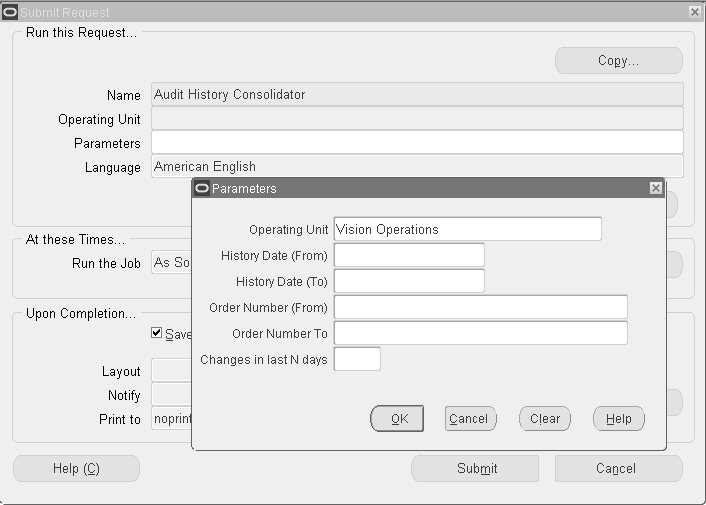
-
Enter the History Date From. This field is optional.
-
Enter the History Date To.This field is optional.
-
Enter the Order Number From. This field is optional.
-
Enter the Order Number To. This field is optional.
Note: Note: If the order number is more than 10 characters then the order number in the audit history report is displayed as @ *********.
-
Enter a numeric value in the Changes in Last N days field to capture audit history changes captured over a period of days. For example, if you wish to consolidate order changes captured for audit purposes during the last 7 days, enter the value 7.
-
Select OK, then Submit.
Note: Order Management recommends your schedule this report based upon your business needs.
Re-Schedule Ship Sets Concurrent Program
The Re-Schedule Ship Sets concurrent program is utilized to re-schedule Ship Sets to the earliest finite supply date, for all order lines within the set. The time fenced used in the calculation is the time fence defined for the ATP rule linked to the order line item.
Note: If order lines are scheduled based on the Infinite Supply Time Fence you can submit this program to reschedule order lines to secure a more practical (and the best) Earliest Available Date. This program will process order lines only if the lines are part of the set.
To re-schedule Ship sets via concurrent program:
-
Navigate to the Order Management Standard Request Submission window, and select Re-Schedule Ship Sets.
Order Management Standard Request Submission Window
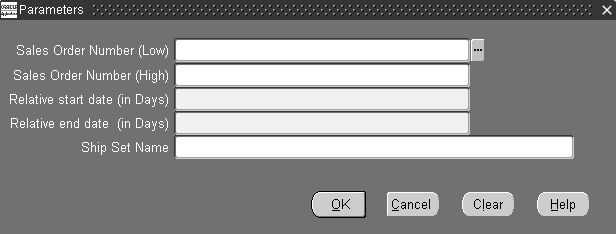
-
Determine the orders you wish to attempt Ship Set rescheduling for. Select a value for the Sales Order Number (low), Sales Order Number (high), or a combination of sales order numbers. These fields are optional.
-
Determine the date or dates you wish to include re-scheduling of Ship Sets from or to. Enter a value for the Relative Start Date (in days), Relative /End Date (in days), or a combination of Relative Start/End Dates (in days). These fields are required.
-
Re-schedule a Ship Set by Set Name. Select a value in the Ship Set Name field. This field is optional.
-
Select OK, then Submit.
Reserve Orders Concurrent Program
The Reserve Orders concurrent program attempts to reserve items as specified by input parameters. The concurrent program attempts to reserve any order lines (for order line types that support Reservations) that are scheduled, and have quantity for complete fulfillment. Reserve Orders supported two modes for scarce inventory (Fair Share and Percentage). It supports a third mode, Partial. Using Reserve Orders, you can choose whether to reserve or simulate reservations.
Note: For input parameters where you can specify a range (Low and High values):
-
If you specify a Low value and not a High value, this program will reserve all order lines that meet or exceed the Low value.
-
If you specify a High value and not a Low value, the program will reserve all order lines equal to or less than the High value entered.
Note: When the parameter Reservation Run Type is Create Reservation for Set, only the Set Name parameter will be honored and all other parameters will be ignored. The concurrent program will attempt to process the data within the specified Set.
To Reserve Orders via concurrent program:
In this release Reserve Orders Concurrent Program can be run across operating units.
-
Navigate to the Order Management Requests window, and select Reserve Orders.

-
Operating Unit: This parameter can be defaulted or specified at run time. If this program is run for a specific Operating Unit then list of values for operating unit dependent parameters will be validated against the Operating Unit entered. Else those parameters will show appropriate values for all Operating Units the user has access to.
-
Use Reservation Time Fence: Select from
-
Yes: Include the value of the Order Management system parameterOM: Reservation Time Fence when reserving orders and lines utilizing this concurrent program.
-
No: Do not include the value of the Order Management system parameter OM: Reservation Time Fence when reserving orders and lines utilizing this concurrent program.
If you do not enter a value for this parameter, then Order Management interprets a null value as equivalent to Yes.
-
If you do not specify a value for this parameter, and the system parameter OM: Reservation Time Fence is set to NULL, the order line will not be processed for generating a reservation.
-
If this parameter is set to Yes, and Order Management system parameter OM: Reservation Time Fence is set to NULL, the order line will not be processed for generating a reservation.
-
-
-
Order Number (High): Select an order number to reserve order lines for. If you do not specify an order number, the system will attempt to reserve all order lines during concurrent program execution.
-
Reserve orders for a specific customer by selecting a value for Customer. All order lines for a customer that are not currently reserved will be processed for reservations during the execution of this concurrent program.
-
Reserve orders for a specific Order Type by selecting a value for Order Type.
-
Reserve order lines for a specific Line Type by selecting a value for Line Type.
-
Reserve orders by warehouse (organization) by selecting a value for Warehouse.
-
Reserve order lines by item by selecting a value for Item.
-
Reserve orders by Line Requested Date by entering a value for Line Request Date Low, Line Request Date High, or a range of line requested dates by entering a value for Line Request Date (Low/High).
-
Reserve orders by Scheduled Ship Date by entering a value for Scheduled Ship Date Low, Scheduled Ship Date High, or a range of Scheduled Ship Dates by entering a value for Scheduled Ship Date (Low/High).
-
Reserve orders by Scheduled Arrival Date by entering a value for Scheduled Arrival Date Low, Scheduled Arrival Date High, or a range of Scheduled Arrival Dates by entering a value for Scheduled Arrival Date (Low/High).
-
Reserve orders by Ordered Date by entering a value for Ordered Date Low, Ordered Date High, or a range of ordered dates by entering a value for Ordered Date (Low/High).
-
Reserve orders by Demand Class. Enter a Demand Class previously defined within the system.
-
Reserve orders by Planning Priority. Enter the Planning priority previously defined within the system
-
Determine the processing order that the concurrent program will utilize during execution within the Order By field. Existing supply will be reserved on the basis of you choice. If you choose a value that utilizes a date, the earliest date available will be the first order processed for reservations, based upon you other input parameters selected.
For example, if you select Date Ordered, then the order with the earliest Order Date (based upon all other input parameter values) will be processed initially. Select from:
-
Actual Arrival Date
-
Date Ordered
-
Date Requested
-
Planning Priority
-
Promised Date
-
Scheduled Ship Date
-
-
Select OK, then Submit.
The log file generated as a result of a submission of the Reserve Orders concurrent program displays all internal order line ids' selected for processing based upon the input parameters entered.
Export Compliance Screening Concurrent Program
The Export Compliance Screening concurrent program can be used to progress order lines that are currently waiting at the Export Compliance Screening Eligible workflow activity. If an order line has initially failed export compliance screening due to data errors, you can attempt to correct the order data, and submit the Export Compliance Screening concurrent program to progress orders and lines past the Export Compliance Screening Eligible workflow activity; export compliance routines are called to perform the compliance screening again.
-
If the order or line pass the screening process during resubmission, orders and lines then progress to the next workflow activity within their respective flows.
-
If the order or lines do not pass the screening process, they will again be waiting at the Export Compliance Screening Eligible workflow activity.
Note: You cannot use the Export Compliance Screening concurrent program to initiate export compliance; this program only enables you to progress order lines past the Export Compliance Screening Eligible activity within the Export Compliance Screening subprocess.
To progress waiting at the Export Compliance Screening Eligible activity:
-
Navigate to the Order Management Standard Request Submission window, and select Export Compliance Screening.

-
Progress export compliance order lines by Order Number. Enter a value for in the Order Number Low, Order Number High, or range of order numbers to include by entering a value for both fields. Additionally, leave these fields blank to progress all order lines.
-
Progress export compliance order lines by Customer. Enter a value in the Customer field.
-
Progress export compliance order lines by Customer PO. Enter a value in the Customer PO number that corresponds with the purchase order received from your customer.
-
Progress export compliance order lines by Order Type. Select a value for the Order Type field.
-
Progress export compliance order lines by Warehouse (organization). Select a value for the Warehouse field.
-
Progress export compliance order lines by Line Ship To Location. Select a value for the Line Ship To location.
-
Progress export compliance order lines by Item. Select or enter an value in the Item field.
-
Progress export compliance order lines by Line Scheduled Date. Select a value for Line Schedule Date Low, an optional value for Line Schedule Date High, or by selecting a value for both fields.
-
Progress export compliance order lines by Order Date. Select a value for Order Date From, an optional value for Order Date To, or by selecting a value for both fields. This field is required.
-
Select OK, then Submit.
Diagnostics: Apps Check Concurrent Program
This program provides summary output details for Oracle Application schema's. Details such as product installation status, application profile values, invalid objects, package versions, database triggers, and form versions are displayed within the program output based upon the Oracle Applications you select as an input.
You can choose to display an output for a single Oracle Application, up to five Oracle Applications, or all Oracle Applications. Order Management recommends that you submit the program with at least one Application Name for the input parameters defined; each subsequent Application Name selected increases the program run time.
The following lists the entities, along with the current value, for each Oracle Application selected by the input parameters that will be displayed within the program logfile.
-
Customer/Business Unit Details
-
Installed Products
-
Database Name and Creation Date
-
Oracle Version(s)
-
Database Parameter Settings
-
Patch Set/Release Information
-
Patches Applied
-
Profile Option Values
-
OM System Parameters
-
Database Triggers
-
Table Indexes
-
Packages Versions and Status
-
Invalid Objects/Errors
-
Invalid Referenced Objects/Errors from Other Products
-
Product Tops
-
Table/View Definition File Versions
-
LDT File Versions
-
Forms Tool Version
-
Product Form Versions
-
Product Library Versions
-
Product Report Versions
-
Executable Versions
To review Oracle Application details:
-
Navigate to the Order Management Standard Request Submission window, and select OM Diagnostics: OM Check.
Apps Check Input Parameters Window
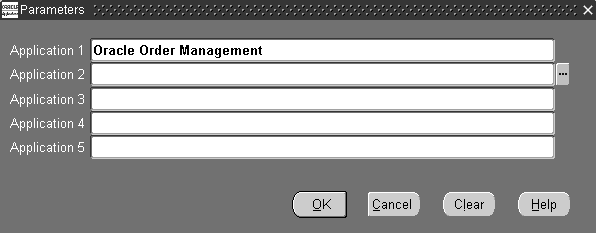
-
Enter or select a value for the optional input parameters Application1 through Application5.
Oracle Order Management, Oracle Pricing, and Oracle Shipping are automatically defaulted for input parameters Application1through Application 3, respectively; these values may be changed. If you clear the Application1 through Application3 input parameter defaults, the program output will display data for all Oracle Applications.
-
Select OK, then Submit.
Diagnostics: OM Debug File Retrieval Concurrent Program
This concurrent program will retrieve Order Management Debug files generated by a user for review on-line. The value of the profile option OM: Debug Log File Directory determines the location the concurrent program will search for the log file specified in the input parameter to this program.
You can also submit this concurrent program to validate your setup for generating Order Management Debug files. Results are displayed within the program output and will include possible suggestions on how your Debug setup can be fixed.
To retrieve an Order Management Debug file for viewing on-line:
-
Navigate to the Order Management Standard Request Submission window, and select Diagnostics: OM Debug File Retrieval.
OM Debug File Retrieval Input Parameters Window

-
Enter the Order Management Debug file name to retrieve (debug file which was displayed to a user when Debug was turned on). This field is optional.
If you leave this parameter blank, the program will attempt to validate your Debug setup and provide results based upon the validations performed.
-
If the debug file cannot be located, the program will complete successfully, but an error will be displayed within the report log file.
-
-
Select OK, then Submit.
-
Navigate to the View Requests window.
Enter the appropriate criteria in the Find Requests window, select Find, locate your request with your cursor within the Request window, and then select View Output.
Diagnostics: OM Order Information Concurrent Program
This program selects order related data from various Oracle Application product database tables and provides a detailed output for the order selected. Additionally, you can choose to limit order details to a specific order line by specifying the line number prior to submission.
The following lists the entities or attributes and their associated current value which will be displayed within the program output for the order or order line selected by the program:
| - | - | - |
|---|---|---|
| Order/Line Details | Order/Line Workflow Status | Order/Line Workflow Notifications |
| Order/Line Workflow Errors | Line History | Holds |
| Price Adjustments | Drop Ship Sources | PO Requisition Interface Details |
| PO Requisition Details | Requisition Workflow Approval Status | Requisition Workflow Approval Notifications |
| Requisition Workflow Approval Errors | Receiving Shipment Lines | Receiving Transactions |
| Receiving Transactions Interface | Material Supply | Item Reservations |
| WIP Job Schedule Interface | WIP Discrete Jobs | WIP Discrete Job Transactions |
| WSH Trips | WSH Trip Stops | WSH Delivery Legs |
| WSH New Deliveries | WSH Delivery Assignments | WSH Delivery Details |
| WSH Freight Costs | Material Transactions Interface | Material Transactions Temp |
| Material Transactions | Move Transactions | Receivable Interface Details |
| Receivable Interface Errors | Invoice Details | Order Cancellation Report |
To display detailed order or order and order line information:
-
Navigate to the Order Management Standard Request Submission window, and select OM Order Information.
OM Order Information Input Parameters Window

-
Enter the order number you wish to view details for. This field is required.
-
Optionally, choose to limit the program output to display line number details for a specific order by entering a line number.
-
Select OK, then Submit.
Order Import Statistics Concurrent Program
Order Import uses the Cost Based Optimizer of the database for optimizing queries. The Cost Based Optimizer uses generated statistical information to optimize queries. The Order Import Statistics concurrent program gathers statistics that will be used by the cost based optimizer. This concurrent program should be run after data is populated into the interface tables.
The Cost Based Optimizer performs a table analysis of all interface tables related to Order Import for determining optimum record processing. You can choose to submit this program (or not) prior to each submission of the Order Import concurrent program. If you normally process a similar number of interface records, you typically do not need to submit this program. There are no parameters for the submission of the Order Import Statistics concurrent program.
To schedule orders via concurrent program:
-
Navigate to the Run Requests SRS window, and select Order Import Statistics in the Request Name field.
-
Click Submit.
Below is a list of columns that are present in the interface tables, but not available via the Corrections Window:
-
Header
-
ship_to_customer_id invoice_customer_id deliver_to_customer_id sold_to_phone_id supplier_signature supplier_signature_date customer_signature customer_signature_date orig_sold_address_ref order_firmed_date ib_location_code orig_sys_end_customer_ref orig_end_customer_address_ref end_customer_contact_ref end_customer_site_use_code
-
-
Line
-
return_context price_request_code attribute_status ship_to_customer_id invoice_to_customer_id deliver_to_customer_id ship_to_customer_name invoice_to_customer_name invoice_to_customer_number deliver_to_customer_name line_category_code actual_shipment_date planning_priority order_firmed_date actual_fulfillment_date end_customer_site_use_code end_customer_contact_ref orig_end_customer_address_ref orig_sys_end_customer_ref
-
-
Price Adjustments
-
price_adjustment_id
-
-
Pricing Attributes
-
order_price_attrib_id override_flag
-
-
Credits
-
sales_group_id sales_group_updated_flag
-
-
Lotserials
-
quantity2 sublot_number
-
-
Customer Information (Add Customer)
-
site_number location_number org_id is_sold_to_address new_address_id_sold_to
-
Purge Set/ Order/Quote Purge Selection Concurrent Programs
The Purge concurrent program enables you to purge selected closed orders/quotes and their workflow history. You first determine which documents you wish to purge by creating a Purge Set. Once orders/quotes have been selected for purging within a purge set, you can then choose to purge the entire set, a subset of the Purge set, or to cancel the purge. Purging old data creates space in your database and can improve performance of transactions and maintenance.
A purge set is a set which will contain orders to be purged based upon user specified criteria. Purge set can be created in the two following ways:
-
Purge Set Creation using the Create Purge Set Concurrent Program
-
Multi-selection of orders within the Order Organizer window and then invoking the Create Purge Set Concurrent Program from the Tools Menu.
-
In case you are selecting a single order for adding to the Purge Set, please select it explicitly in the Order Organizer window and then create the purge set.
-
You can submit your same purge request on a regular interval for example, weekly or monthly.
Purge Prerequisites
-
The order and quote purge selection program enables you to search for quotes and orders across operating units. By selecting an operating unit, you can choose to restrict your quotes and orders to an operating unit.
-
An Order or quote status must be expired or lost before it can be purged.
-
Once conditions are met, the purge checks to see if all user defined prerequisites have been completed.
-
An Order or quote can be purged only if no open activity exists including: open invoices or open returns.
Note: Order/quote purge capability is available to Oracle Order Management Super Users only. Order/quote purge is submitted by batch process. Function security will control which responsibilities see Purge in the tools menu.
-
Orders can get purged if there are unpaid invoices for them.
Flexible Order/Quote Purge Selection Criteria
You can purge, using selection criteria, from the eligible pool of headers and lines. Once all processing steps for this transaction have been completed, you can view them and choose to purge all orders from the eligible pool which are for a particular customer.
The criteria for Order Purge selection will be based on:
-
Operating Unit
-
Order Number (range)
-
Order Date (range)
-
Creation Date (range)
-
Order Category
-
Order Type
-
Customer
The criteria for Quote Purge selection will be based on:
-
Operating Unit
-
Order Type
-
Customer
-
Expired Quotes
-
Lost Quotes
Review Data to be Purged
You can view all closed orders/lines that meets purge criteria. You can preview preliminary purge candidate listings on the Purge Set window.
Cancel the Purge or Change the Batch Run Time
Order/quote purge is submitted in batch mode, and you can cancel the batch job or change the batch runtime.
View Purged Data
After a purge is complete you can only view the purged data in the Purge Set window. Navigate to the Order/Quote Purge Set window and query by Purge Set name. Purge sets can be submitted for purge, exclude certain orders/quotes within the set from being purged, or completely deleted (provided the records have been previously purged).
Purge Option for Sales Orders with Terms and Conditions
When purging sales orders, you can select the Purge Orders with Contract Terms parameter that specifies whether orders with contractual terms and conditions are eligible for purging. If you select No for this parameter, then the order will not be eligible for purging if it has terms and conditions.
OM: Transactions Purged Per Commit
This profile option can be set only at the site level. The value of this profile option indicates the number of orders/quotes per commit, in order/quote purge processing.
Purge Set Creation using the Purge Set Selection Concurrent Program
To create a purge set by specifying the where (selection) condition
-
Navigate to the Order Purge Selection concurrent Program
Order Purge Selection Parameters Window
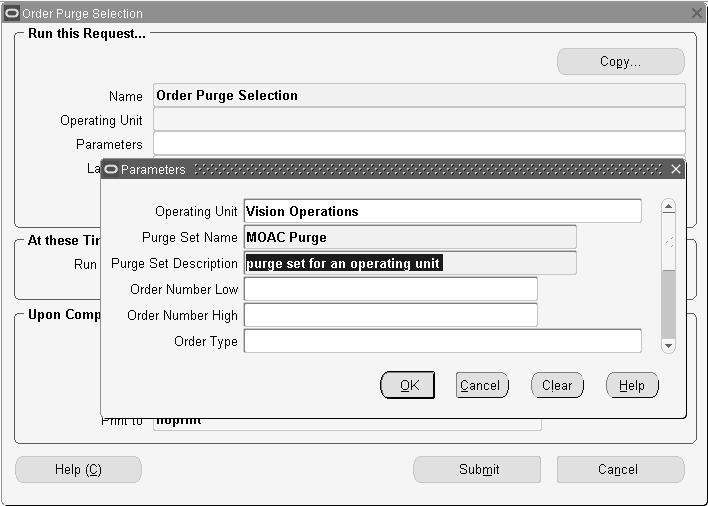
-
Within the Purge Set name field, enter a unique name to identify the purge set.
-
Within the Purge Set Description, enter a description for your purge set.
-
Optionally, determine if you wish to purge a single order number or range of order numbers, by entering values for Order Number Low, Order Number High, or both input parameters. All orders created within the range entered will be selected for purging, provided other input parameters also enable purging.
-
Optionally, determine if you wish to purge orders for a specific Order Type by selecting a value in the Order Type input parameter. All orders created that utilize the Order Type selected will be purged, provided other input parameters also enable purging.
-
Optionally, determine if you wish to purge orders for a specific Order category by selecting a value in the Order Category input parameter. All orders created that utilize the Order Category selected will be purged, provided other input parameters also enable purging.
-
Optionally, determine if you wish to purge orders for a specific Customer Name by selecting a Customer Name in the Customer Name input parameter, provided other input parameters also enable purging.
-
Optionally, determine if you wish to purge orders created on a specific date or range of dates by selecting a value for the Creation Date Low, the Creation Date High, or both input parameters. All orders created for the date range specified are selected within the purge set, irrespective of the current order status.
-
Click Submit.
To create a purge set using Quote Purge selection
-
Navigate to the Quote Purge Selection concurrent Program.
Quote Purge Selection - Parameters
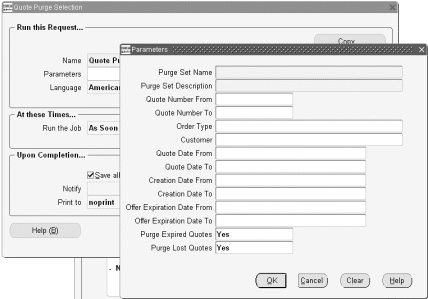
-
Within the Purge Set name field, enter a unique name to identify the purge set.
-
Within the Purge Set Description, enter a description for your purge set.
-
Optionally, determine if you wish to purge a single quote number or range of quote numbers, by entering values for Quote Number From, Quote Number To, or both input parameters. All quotes created within the range entered will be selected for purging, provided other input parameters also enable purging.
-
Optionally, determine if you wish to purge quotes for a specific Order Type by selecting a value in the Order Type input parameter. All quotes created that utilize the Order Type selected will be purged, provided other input parameters also enable purging.
-
Optionally, determine if you wish to purge quotes for a specific Customer Name by selecting a Customer Name in the Customer Name input parameter, provided other input parameters also enable purging.
-
Optionally, determine if you wish to purge quotes created on a specific date or range of dates by selecting a value for the Creation Date From, the Creation Date To, or both input parameters. All orders created for the date range specified are selected within the purge set, irrespective of the current order status.
-
Click Submit.
Purge Set Creation by multi-selection
Create a purge set by selecting multi-selecting orders within the Order Organizer, and then, from the menu, selecting Tools, Purge, Purge Set.
Enter the Purge Set name and a description for the purge set.
-
Click Submit to create a purge set with all the records (orders) you have selected within the Order Organizer.
Process Exceptions
If the selection criteria includes orders/quotes that do not meet the purge restrictions (order is not closed, outstanding reservations exist, etc.) or if the purge process encounters an issue, a process error occurs. These errors can be viewed by viewing the purge set within the Purge Set window.
For example, suppose when submitting the Order Purge Selection concurrent program a user specified all orders for customer Business World. When you navigate to the Order Purge window, you may find certain orders were ineligible for purge, and have been marked as such (within error column, a note would display the order is not closed, and the Eligible check box is not enabled).
To review purge set details:
Purging within Operating Units
You can process only those purge sets that you have created, though you can view all the purge sets created. If a purge set you process has orders in an Operating Unit that you no longer have access to, the Order Purge program will not purge those orders and an error message will be displayed.
-
Navigate to the Purge Set window.
Purge Set Window - Purge Criteria Tab
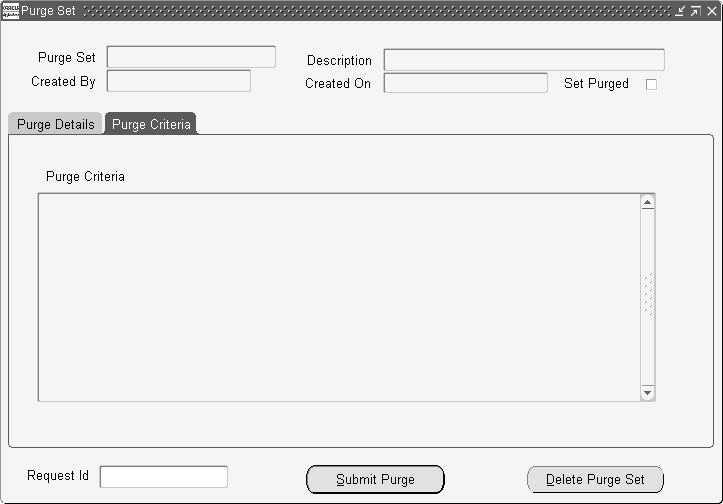
The Purge Set window displays the following attributes of a Purge Set:
-
Purge Set Name
-
Purge Set Description
-
(Purge Set) Created By
-
(Purge Set) Created On
-
Set Purge check box (selected if Purge Set has been purged)
-
Request ID (request id if Order Purge concurrent Program has been submitted)
Purge Set Window - Details Tab
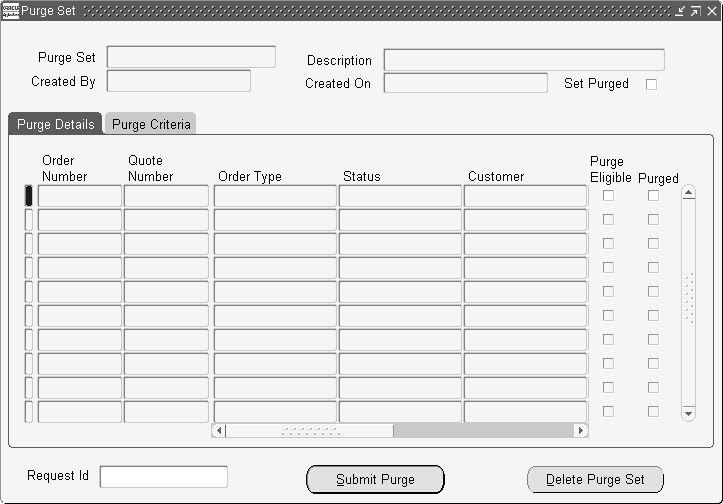
-
Quote Number
-
Order Number
-
Order Type
-
Customer (name)
-
Expiration Date Error (error during purging)
-
Purge Eligible check box (enabled if order is eligible for purging, and also if order has been purged)
-
Purged Check box (enabled if order has been purged)
Purge Criteria Tab
-
Purge criteria for the Purge Set displayed; based upon the values entered for the Purge Set name when submitting the Order Purge Selection concurrent Program
-
-
Choose to:
-
Exclude orders selected within a Purge Set by de-selecting the Purge Eligible check box, and then submit the Purge set for purging by click Submit Purge
-
Purge the entire set by clicking Submit Purge
-
Delete a Purge Set that has not previously been purged by clicking Delete Purge Set
To purge orders or quotes using a purge set in the Order Organizer:
Navigate to the Order Organizer window and query your closed orders or closed quotes to purge.
-
-
Choose Tools > Create Purge Set. The Order Organizer, Create Purge Set window appears.
-
Choose Submit to create the purge set.
Note: This method of creating a purge set is recommended only for a low volume of orders. For high a volume of purge data (e.g greater than 100 orders) the order/quote purge selection (using the concurrent program) is recommended.
To create an order purge set by specifying a where condition:
To create a purge set by specifying a where (selection) condition, select the Purge > Order Purge Selection from the navigator.
-
Enter the Purge Set Name, Description, and the desired selection criteria and click OK.
-
Click Submit on the subsequent request screen.
To create a purge set repeat steps 1-3 and replace the order purge selection with the quote purge selection in step1.
-
View Order Purge
After creating the purge set using either of the above methods, the orders or quotes in that purge set can be viewed on the Purge Set window. The purge set now can be either submitted for purge, or if required some of the orders or quotes can be excluded from the purge set using this window, or the purge set can be deleted. To review the purge set open the following window from Navigator Purge > Purge Set. This window is also available from Purge option of Tools menu of Order Organizer. On this window purge sets can be queried by purge set name. If the purge set has been created using a selection criteria the purge criteria can also be viewed.
Messages
Message Name: OE_PUR_ADD_ORDER
Message Text: This Order is ineligible for purging.
Description: This message is issued when the user tries to include an order into purge set.
Message Name: OE_PUR_DELETE_PURGE_SET
Message Text: You cannot delete a purge set that has some orders that have already been purged.
Description: This message is issued when user tries to delete a purge set, from which some orders have been purged.
Message Name: OE_PUR_DELETE_PURGE_SET_OK
Message Text: Delete Purge Set &PURGE_SET_NAME
Description: This message is for confirmation of delete.
Message Name: OE_PUR_PURGE_SET_DELETED
Message Text: Purge Set &PURGE_SET_NAME Deleted.
Description: This note is issued after the deletion of a purge set.
Message Name: OE_PUR_PURGE_SET_PURGED
Message Text: You cannot delete a purge set that has already been purged.
Description: This message is issued when a user tries to delete/submit a purge set.
Message Name: OE_PUR_REQUIRED
Message Text: Field must be entered.
Description: Message for a required field.
Message Name: OE_SRS_TITLE_GENERATE_PURGESET
Message Text: Order Purge Selection.
Description: Title for order purge selection.
Message Name: OE_PUR_CREATE_SUBMITTED
Message Text: Create purge set submitted with request id = &REQUEST_ID.
Description: Message issued when create purge set is submitted.
Message Name: OE_PUR_ORDER_PURGE_SUBMITTED
Message Text: Order purge submitted with request id = &REQUEST_ID.
Description: Message issued when order purge is submitted.
Message Name: OE_PUR_OPEN_ORDER
Message Text: Order is open.
Description: Message issued when an order is open.
Message Name: OE_PUR_OPEN_INVOICES
Message Text: Open invoices exist for this order.
Description: Message issued when open invoices exist for an order.
Message Name: OE_PUR_OPEN_RETURNS
Message Text: Open returns exists for this order
Description: Message issued when open returns exists for an order.
Message Name: OE_PUR_CANNOT_SUBMIT
Message Text: Purge set is already purged.
Description: Message issued when a user tries to submit order purge for a purge set which has already been purged.
Messages For Quotes
Message Name: OE_PUR_ADD_QUOTE
Message Text: This quote is ineligible for purging.
Description: This message is issued when a user tries to include a quote into purge set.
Message Name: OE_PUR_OPEN_QUOTE
Message Text: Quote is open.
Description: Message issued when Quote is open.
Message Name: OE_SRS_TITLE_GENERATE_QUOTE_PURGESET
Message Text: Quote Purge Selection
Description: Title for Quote purge selection.
Purchase Order Related Purge Changes
Message Name: OE_PUR_OPEN_PO_REQ
Message Text: Open drop ship PO/Requisition exists for externally sourced line of this order.
Description: This message is issued when there is an open PO or requisition existing for an order that has drop ship order lines.
Batch Price Concurrent Program
The Batch Price concurrent program attempts to price orders or order lines as specified by input parameters. The concurrent program attempts to price any orders or lines that have an open status. Batch Pricing honors the Calculate Price Flag on the individual order lines.
For input parameters where you can specify a range (Low and High values):
-
If you specify a Low value and not a High value, this program will price all order lines that meet or exceed the Low value.
-
If you specify a High value and not a Low value, the program will price all order lines equal to or less than the High value entered.
To perform batch price via the concurrent program:
Preview Mode: This is a mandatory parameter. If you select Yes, then the concurrent program will not price or re-price the orders or lines, it will only list the order and line details that will be impacted if batch pricing is run with the specified parameters. Preview mode is useful if you want to see the effect of the pricing or re-pricing on the orders and lines for the specified input parameters. You can then decide if you wish to run the concurrent program in execute mode (when Preview Mode is No) or not. If you select No, then the concurrent program runs with the parameters you specify and prices or re-prices the orders and lines. The price is fetched from the price list defaulted on the order / line by the relevant API.
Pricing Level: This is a mandatory parameter. You can select between order level pricing and line level pricing to determine whether line level or list level modifiers get applied. If you select order level pricing, and the order status is Entered, then the Pricing API is called with the Batch event. If at order level pricing, the order status is Booked, then the Pricing API is called with the Batch, Book and Ship events. If you select line level pricing, the Pricing API is called with the Line event only, irrespective of the line status (booked or otherwise).
Operating Unit: The Batch Price concurrent program can be run across operating units. You can specify All or a given operating unit for the orders/lines that you want priced or re-priced.
Order Number (Low/High): Select an order number to price or reprice order lines for. If you do not specify an order number, the system will attempt to reprice all order lines during concurrent program execution.
Order Type: Select an Order Type that you want to specify.
Line Type: Select a Line Type. This parameter is disabled if you have selected Order Level pricing at the Pricing Level parameter.
Booked Orders: If you select Yes, then only booked orders will be priced/re-priced. If you select No, then orders with a status Entered will be priced/re-priced. If you leave this parameter blank, then the concurrent program will select all open orders/lines irrespective of their booked status.
The following parameters are enabled only if the Pricing Level selected is Line:
-
Item
-
Item Category
-
Warehouse
-
Line Creation Date (Low and High)
-
Pricing Date (Low and High)
-
Schedule Ship Date (Low and High)
Select OK, then Submit. The log file generated as a result of a submission of the Batch Price concurrent program displays all order details selected for processing based upon the input parameters entered.
Purge Order Management Workflow Concurrent Program
This concurrent program purges workflow items associated with Oracle Order Management, such as OM Order Line and OM Order Header. Unlike the Purge Obsolete Workflow Runtime Data program provided by Oracle Workflow, the Purge Order Management Workflow program purges workflows of closed sales order lines even if the sales order header is still open. It tries to close open workflows in a few very specific cases to make more workflow items eligible for purge. Use this purge program to reduce the size of workflow tables and improve high volume order processing performance.
To purge Order Management workflows of closed sales orders:
-
Navigate to the Submit Request window and select Purge Order Management Workflow.
-
Select the workflow item type to purge the closed workflows corresponding to a single item type. The default value for this parameter is All Item Types. If you do not select any item type, then the concurrent program purges all the closed workflows, corresponding to workflows of type OM Order Header.
-
Enter the unique identifier of the workflow item that you want to purge. The application uses this information to purge the workflow corresponding to the workflow item key.
-
Enter the number of elapsed days after closure to purge workflows that were completed no later than this many days ago.
-
Select an applicable Attempt to Close option. If the workflow item type is OM Order Header or All Item Types, then the concurrent program identifies and attempts to close all the header workflows that are open due to pending line closure, even though all the lines in the order are in fact closed. If the workflow item type is OM Error, then the concurrent program identifies all the OM Error and WF Error flows that are either orphan, or those that are associated with OM flows that are no longer in error. The program completes the error flows and purges them.
-
Enter the purge frequency of the workflow data. The default value is 500. The application issues commits to the database engine after every 500 purged workflow items.